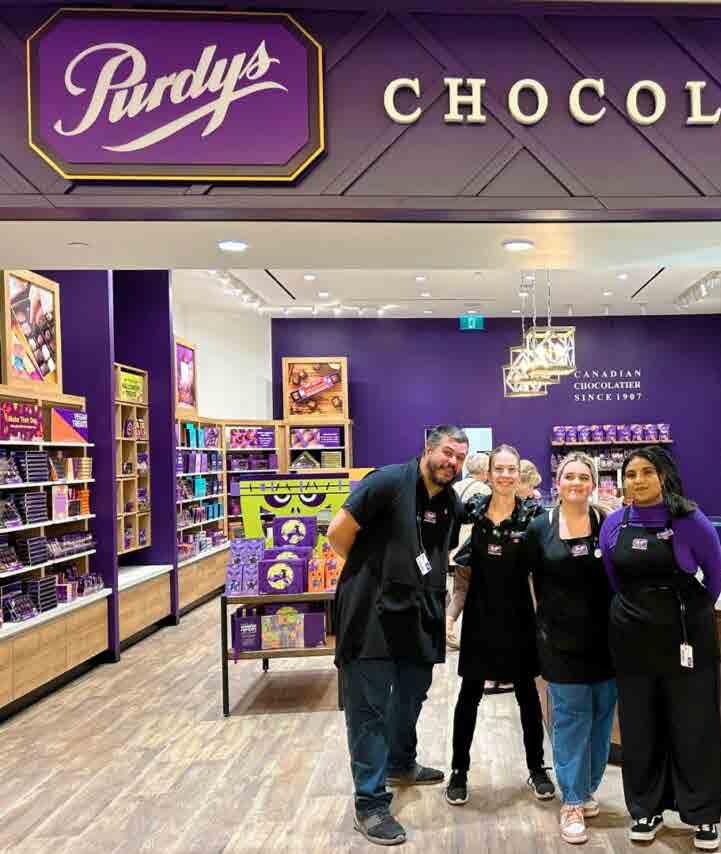
5 minute read
Purdys: a sweet take on Canadian pride and the future of retailing in Canada
Purdys Chocolatier President Lawrence Eade discusses the brand’s Canadian heritage, rising cocoa prices, trade tariffs, and the company’s growth strategy // By Craig Patterson
For over a century, Purdys Chocolatier has been a staple in Canadian confectionery, bringing premium chocolate to generations of consumers. Founded in 1907 in Vancouver, the company has remained steadfast in its commitment to Canadian production, community engagement, and sustainable sourcing. Despite external challenges, including rising cocoa prices and ongoing trade uncertainties, Purdys continues to thrive, adapting to industry shifts while maintaining its dedication to quality and ethical sourcing.
A Proudly Canadian Brand
“Purdys is about as Canadian as you can get,” says Lawrence Eade, President of Purdys Chocolatier. “We were founded in 1907 in Vancouver, and our factory has been in Vancouver ever since. We’ve moved and grown, but we’ve always stayed here. Now, we’re coast to coast, from Victoria to Ottawa. We sell and make everything here in Canada in our own channels.”
The company’s Canadian roots run deep, with over 1,100 employees nationwide. Purdys has also made a name for itself through its Purple Partnerships initiative, supporting Indigenous programs, LGBTQ+ advocacy, and grassroots fundraising efforts that contribute millions of dollars annually to local communities. “It’s all through the power of chocolate,” Eade says. “We help small organizations—whether it’s a hockey team, dance program, or parent advisory council—keep doing what they love in their communities.”
Tariffs, Trade Wars, and Canadian Sentiment
Recent discussions around trade tariffs and potential changes to the de minimis threshold could impact Purdys’ ability to ship products to U.S. customers. “Many of our online orders come from expats and tourists who’ve visited Canada and fallen in love with Purdys,” says Eade. “If tariffs go up, it could affect that segment. We’re working on ways to minimize costs for our American customers.”
However, the silver lining has been a rise in ‘Buy Canadian’ sentiment. “Consumers are focusing on supporting Canadian businesses now more than ever,” Eade says. “When people look for a Canadian chocolate alternative, there aren’t many choices outside of us. The market is dominated by U.S. and European brands. Purdys is one of the few truly Canadian chocolate brands, and we want people to remember that.”
Rising Cocoa Prices: A Global Challenge
The global cocoa market has faced unprecedented price hikes, with costs per metric ton skyrocketing from historical averages of $2,500 to over $12,000 at peak. Eade attributes this volatility to poor crop yields, climate change, and government-led initiatives to improve wages for farmers in West Africa, where 70% of the world’s cocoa originates.
“We’ve been working in West Africa for almost 30 years, supporting farming communities, building schools, and improving agricultural practices,” Eade explains. “These price hikes are partly due to governments trying to ensure farmers are paid fairly, which is an important step forward.”
For Purdys, sustainability is non-negotiable. The company has long promoted the use of 100% sustainable cocoa and has been proactive in integrating ethical sourcing into its business model. “We can make a small but meaningful impact on a global scale,” says Eade.
Supply Chain and Market Shifts
With cocoa prices fluctuating, businesses across the industry are reevaluating their use of chocolate. “Larger-scale companies that use chocolate in ice cream or baked goods are the first to cut back,” Eade notes. “For Purdys, which sells a premium chocolate product, demand has remained steady. Consumers are shifting toward higher-quality products, willing to pay a little more for something special.”
While this trend benefits Purdys, supply chain challenges remain a concern. The company relies on U.S. imports for key ingredients, particularly Georgian pecans for its signature Sweet Georgia Browns. “We’re not changing that,” Eade insists. “We won’t compromise the quality of our chocolates, even if costs increase. We’ll absorb the impact rather than passing it entirely onto the consumer.”

Expansion and Innovation
Despite economic pressures, Purdys remains focused on growth. The company has recently explored pop-up stores as a strategy to test new markets. “We started with three pop-ups two years ago, and they turned into permanent stores in Fort McMurray and Cranbrook, B.C.,” says Eade. “Last year, we launched six more. Some of those locations will also transition to permanent stores.”
Looking ahead, Purdys has its eyes set on Quebec and the Maritimes, two major Canadian markets where it has yet to establish a significant footprint. “There’s plenty of white space in Canada, and we’re being strategic about how we expand,” says Eade. Retail partnerships and store-in-store concepts with major Canadian retailers are also under consideration as part of the company’s broader growth strategy.
The Future of Purdys Chocolatier
As economic uncertainties loom, Purdys remains optimistic about its place in the Canadian market. “We’re a well-known brand, but sometimes people forget about us until the holidays,” Eade admits. “Christmas, Easter, and Valentine’s Day are our big seasons, but we want to remind consumers that we’re here for celebrations yearround—whether it’s Eid, Diwali, or just a small moment of indulgence.”
With a legacy spanning over 100 years, Purdys Chocolatier stands as a testament to Canadian resilience, quality, and community spirit. While global challenges persist, the company’s commitment to ethical sourcing, premium products, and Canadian values positions it for continued success in the years to come.
“Businesses adapt,” says Eade. “As Winston Churchill said, ‘Never waste a good crisis.’ We’ll keep finding ways to grow, support our communities, and deliver the best chocolate in Canada.”







